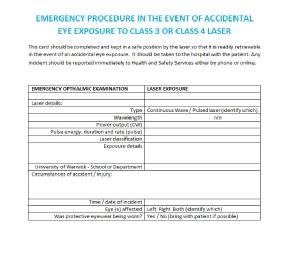Emergency Protocol for Labs, Workshops and Associated Stores
Note – This is general advice, the safety data sheet must be consulted for specific information.
Users of substances hazardous to health should know what they would do in the event of a foreseeable emergency event and relevant First Aid and Spillage Equipment should be present in the vicinity to support you.
Spillage
In the event of spillage outside a fume cupboard or local exhaust enclosure:
* If the substance is flammable, eliminate sources of ignition;
* Instruct others to keep at a safe distance;
* Open windows where appropriate;
* For spillage of volatile materials, evacuate the room and shut the door unless the substance has been determined to be safe to use in the open. Unless the spillage is one which may be left to clear by evaporation and ventilation, call Community Safety who will call the Emergency Services.
* For spillage of material which has been determined safe to use in the open, absorb it onto sand or proprietary absorbent, and transfer it into a container which is put into a well-ventilated space for ultimate disposal.
* If external to the premises, prevent spills from entering drains or watercourses by creating a bund and using absorbent materials, then transfer to a container for ultimate disposal.
* If trained to deal with a spill locally, identify relevant materials from a local spillage kit, don relevant personal protective safety equipment and mitigate the spill from entering any drain.
*Those working with biological materials should have a plan in place for the management of foreseeable spills relating to their work and should take the action required, as per the risk assessment.
Toxic Gas Leakage
If a compressed gas is leaking and cannot be shut off, feed the gas (if possible,) into a fume cupboard or other ventilation discharging directly to the outside. If this is not possible then for a small leak, where practicable, transport the leaking gas cylinder to the open air and clear the surrounding area. Otherwise evacuate the room, if possible opening windows before leaving. Report what action you have taken to a Supervisor / Technical Team member who may decide to take further action, i.e. to raise the fire alarm to evacuate the building, for example.
Unknown Vapour Cloud / Strong odour
If you spot a visible vapour cloud (not arising from a gas line) or smell a strong odour in the vicinity and there is nobody working in the area, evacuate the space and report this immediately to the Technical Team and Community Safety, who may decide to take further action.
Gas Leak / Fire where gas is in use
Some laboratories are fitted with piped in natural gas. If you can smell gas and the bunsen burners and gas taps are all turned off, or if you need to shut off the gas due to a fire incident, if you cannot get near to the local gas tap, hit the local emergency gas isolation shut off button in the lab. Report the matter to your Supervisor and the Technical Team, who may decide to take further action, e.g. to evacuate the building
Laser exposure to eye from a Class 3B or Class 4 Laser
All beams must be safely isolated or the power to the laser switched off. In addition, all other potential hazards must be made safe e.g. electrical, biohazard, trip hazards. Seek First Aid assistance.
The Emergency Procedure Card (AOR005) that is displayed in the laboratory (as below) must be completed and taken to the hospital with you. This card looks like this but can be downloaded from the Starting Work with Lasers Link opens in a new windowwebpage if not available:
First Aid
Workers should know what help to give before qualified help arrives on the scene. There will be specific special procedures for certain activities - notably for hydrofluoric acid and cyanides, otherwise the basic procedure is as follows:
Eyes
Flood thoroughly with water for at least 10 minutes. Use sterile eyewash or tap water from a clean container or run gently from a hose. Gently, but if necessary firmly, prise eyelids open. SEEK IMMEDIATE MEDICAL ATTENTION.
Skin
Drench with plenty of water. Remove contaminated clothing. Continue with running water for 10 minutes. Do not scrub or break the skin surface. Unless contact has been slight SEEK IMMEDIATE MEDICAL ATTENTION.
Lungs
Remove affected personnel from area of exposure, without putting yourself in danger (i.e. do not enter a room where the general atmosphere appears to be dangerous - call the Fire Brigade). Rest them and keep them warm. Unless exposure has been slight and the patient feels quite well, SEEK IMMEDIATE MEDICAL ATTENTION.
Mouth
DO NOT INDUCE VOMITING OR GIVE ANYTHING TO DRINK. If the chemical has been confined to the mouth give large amounts of water as mouth wash - ensure mouth wash is not swallowed. SEEK IMMEDIATE MEDICAL ATTENTION.
Reporting
Report accidents and incidents online via the Health and Safety Services online portal (Assure)Link opens in a new window.
Wherever there is reason to believe that someone has had a higher than acceptable level of exposure to a substance, or where they suspect that their health might have been affected by exposure to substances at work it MUST be reported to Health and Safety Services.
Waste Disposal
Ultimate disposal of waste should be part of the planning for any procedure.
Waste solvent should be disposed of into the containers provided for halogenated or non-halogenated waste. If it is contaminated with strong acid or alkali it should be neutralised before disposal to prevent corrosion of, and subsequent leaking from, the metal drums into which waste solvent is eventually bulked.
Other waste chemicals should be clearly identified with hazard pictograms on the container as appropriate. In some cases it will be necessary to treat the waste to make it less hazardous before the waste is accepted. See 'Hazardous WasteLink opens in a new window' for further details.

